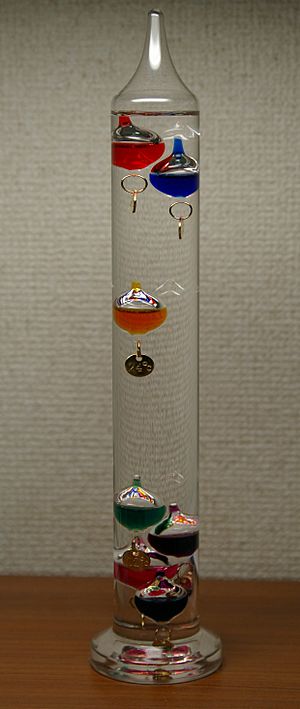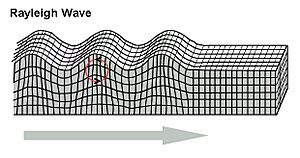History of geophysics facts for kids
Geophysics is the study of Earth using physics. It helps us understand our planet. People have always been curious about Earth. They also want to use its resources like oil and water. Geophysics also helps us deal with natural dangers. These include earthquakes, volcanoes, and tsunamis.
Contents
Early Discoveries and Observations
People have studied Earth for a very long time. They used simple observations and tools.
Measuring Earth's Size
Around 240 BC, a smart person named Eratosthenes figured out Earth's size. He used math and the Sun's angle in different places in Egypt. He found a very good estimate for the circumference of Earth.
Early Ideas About Earthquakes and Volcanoes
Ancient thinkers like Aristotle and Pliny the Elder wrote about earthquakes. They also observed ocean tides. The Greek philosopher Empedocles thought volcanoes were caused by "elemental fire." He believed winds and earthquakes played a big role. Later, Pliny the Elder noticed that earthquakes often happened before a volcano erupted. A scientist named Athanasius Kircher explored volcanoes like Mount Etna and Vesuvius. He thought Earth had a central fire connected to others. These fires were caused by burning things like sulfur and coal.
Tools and Scientific Study
As science grew, people started using better tools and math. This helped them understand Earth even more.
Earth's Magnetism and Gravity
In 1600, William Gilbert wrote an important book. He showed that compasses point north because Earth itself is like a giant magnet. Later, in 1687, Isaac Newton published his famous book, Principia. This book explained how gravity works. It also helped explain tides and how Earth wobbles slightly as it spins. Scientists like Pierre Bouguer and Henry Cavendish studied Earth's shape, weight, and gravity. Others like Alexander von Humboldt and Carl Friedrich Gauss explored Earth's magnetic field.
Studying Water and Weather
People also started to understand the water cycle. Thinkers like Leonardo da Vinci described how water moves from the sky to the ground and back. Pioneers in hydrology (the study of water) measured rainfall and river flow. In the 18th century, new tools like the piezometer and Pitot tube helped measure water pressure and speed. In the 19th century, scientists learned more about groundwater. The first textbook about oceans, Physical Geography of the Sea, was written in 1855.
New tools also helped study the air. Galileo Galilei made the first thermometer in 1607. In 1643, Evangelista Torricelli invented the mercury barometer. This tool measures air pressure. Blaise Pascal later showed that air pressure gets lower as you go higher up.
Geophysics Becomes a Field of Study
The word "geophysics" was first used in 1834. It slowly became more common. Journals and institutes focused on geophysics started to appear. In 1898, the first Geophysics Institute was created in Germany. Emil Wiechert became the first professor of geophysics. In 1919, the International Union of Geodesy and Geophysics was formed. This helped scientists from different countries work together.
The 20th Century: Big Changes
The 20th century brought huge changes to geophysics. The International Geophysical Year (1957-1958) was a big international effort. Scientists studied many things, including:
- Northern Lights
- Cosmic rays
- Earth's magnetism
- Gravity
- Oceanography
- Seismology (study of earthquakes)
- Solar activity
Earth's Inside and Earthquakes
Scientists learned a lot about Earth's inside. This was possible because of new tools called seismographs. These tools measure ground shaking from earthquakes. By studying how earthquake waves travel through Earth, scientists learned about its layers. In 1936, Inge Lehmann discovered that Earth has a solid inner core. Scientists like Beno Gutenberg and Harold Jeffreys explained how Earth's density changes. They also studied how fast waves travel through different layers.
Scientists named different types of earthquake waves:
- P-waves and S-waves are body waves that travel through Earth.
- Love waves and Rayleigh waves are surface waves that travel along Earth's surface.
Many scientists helped us understand Earth's interior and earthquakes. These include Emil Wiechert, Beno Gutenberg, Inge Lehmann, and Charles Francis Richter.
One idea about Earth's inside is "mantle plumes." These are thought to be rising hot rock from deep inside Earth. They might cause hot spots like Hawaii. Scientists are still studying how these plumes work.
Plate Tectonics: Moving Continents
In the second half of the 20th century, the plate tectonics theory was developed. Many scientists contributed to this idea. Before this, people had ideas about continents moving. But there wasn't much proof. Alfred Wegener was a key scientist. He suggested that all continents were once joined in a supercontinent called "Pangaea".
At first, people mainly studied the land. But then they started exploring the ocean floor. They found that the ocean floor was spreading apart. This happens at different speeds in different places. Earth's outer layer is made of large plates. These plates are always moving. They can move in three main ways:
- Transform: Plates slide past each other.
- Divergent: Plates move apart.
- Convergent: Plates crash into each other.
Sometimes, land can also start to pull apart, forming rifts.
Oceanography: Exploring the Deep Sea
The 20th century saw big steps in studying the oceans. In 1914, people first used sound to measure sea depth. A German expedition in the 1920s used echo sounders. They mapped the Mid-Atlantic Ridge. In 1951, the HMS "Challenger" expedition found the deepest part of the ocean, the Challenger Deep. In 1953, the Great Global Rift was discovered. Scientists also found a mountain range under the Arctic in 1954. The idea of seafloor spreading was developed in 1960. Since then, computers have helped scientists predict ocean conditions.
Geomagnetism: Earth's Magnetic Shield
Earth's magnetic field comes from the movement of hot, melted metal deep inside our planet. This is like a giant dynamo. The magnetic field protects us from harmful radiation from the Sun. Scientists have found that Earth's magnetic poles have flipped many times. This helps us understand what Earth's surface was like in the past. We don't know exactly why the poles flip. The timing of these flips is also not regular.
The Aurora Borealis, or Northern Lights, happens because of Earth's magnetic field. Energy from the Sun's particles (solar wind) gets stored in the magnetic field. When this energy is released, we see the beautiful lights.
How the Atmosphere Changes Earth
Earth's climate changes over time. This is due to the air's makeup, the Sun's brightness, and big events.
The air's makeup affects and is affected by living things. Plants and animals change the levels of oxygen and carbon dioxide. Humans also change the air by burning fuels and cutting down forests. The ocean can take in carbon dioxide.
The Sun's brightness changes slowly over millions of years. Sunspots on the Sun can also cause changes in the energy Earth receives.
Volcanoes form where Earth's plates meet. When a volcano erupts, it can affect the climate. Scientists like Alan Robock think volcanic activity can cause global cooling for years. This is because sulfur dioxide gas from volcanoes can block sunlight.
Big impacts from space rocks, like asteroids, can also change the atmosphere. They send dust into the air, blocking sunlight. This can cause global cooling and harm many species.
Geophysics in Industry
Geophysics is also used in industries. It became very important in the 1920s for finding oil. Later, it helped find other resources like minerals and groundwater. In the 1990s, geophysics started helping to reduce earthquake dangers. It also helps check building sites in earthquake areas.
In mining, seismology helps understand ground movements. This helps predict dangers in mining areas. Seismic waves are also used to map underground features. This helps find places where oil might be trapped.
Groundwater can easily get polluted. Geophysics helps map groundwater depth. This helps protect our fresh water sources from pollution.
See also
- History of geology
- History of geomagnetism
- Timeline of the development of tectonophysics




